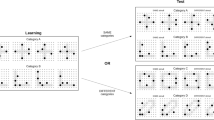Abstract
It has been shown that in associative learning it is possible to disentangle the effects caused on behaviour by the associations between a stimulus and a classification (S–C) and the associations between a stimulus and the action performed towards it (S–A). Such evidence has been provided using ex-Gaussian distribution analysis to show that different parameters of the reaction time distribution reflect the different processes. Here, using this method, we investigate another difference between these two types of associations: What is the relative durability of these associations across time? Using a task-switching paradigm and by manipulating the lag between the point of the creation of the associations and the test phase, we show that S–A associations have stronger effects on behaviour when the lag between the two repetitions of a stimulus is short. However, classification learning affects behaviour not only in short-term lags but also (and equally so) when the lag between prime and probe is long and the same stimuli are repeatedly presented within a different classification task, demonstrating a remarkable durability of S–C associations.


Similar content being viewed by others
References
Aarts E, Roelofs A, van Turennout M (2009) Attentional control of task and response in lateral and medial frontal cortex: brain activity and reaction time distributions. Neuropsychologia 47:2089–2099
Ashby FG, Ennis JM, Spiering BJ (2007) A neurobiological theory of automaticity in perceptual categorization. Psychol Rev 114:632–656
Heathcote A (1991) Analysis of response time distributions: an example using the Stroop task. Psychol Bull 109:340–347
Hockley WE (1982) Retrieval-processes in continuous recognition. J Exp Psychol Learn 8:497–512
Hockley WE (1984) Analysis of response-time distributions in the study of cognitive-processes. J Exp Psychol Learn 10:598–615
Hohle RH (1965) Inferred components of reaction times as functions of foreperiod duration. J Exp Psychol 69:382–386
Hsu YF, Waszak F (2012) Stimulus-classification traces are dominant in response learning. Int J Psychophysiol 86(262):8
Kinoshita S, Hunt L (2008) RT distribution analysis of category congruence effects with masked primes. Mem Cognit 36:1324–1334
Koch I, Allport A (2006) Cue-based preparation and stimulus-based priming of tasks in task switching. Mem Cognit 34:433–444
Lacouture YC (2008) How to use matlab to fit the ex-gaussian and other probability functions to a distribution of response times. Tutorials Quant Meth Psychol 4:35–45
Logan GD (1988) Toward an instance theory of automatization. Psychol Rev 95:92–527
Moutsopoulou K, Waszak F (2012) Across-task priming revisited: response and task conflicts disentangled using ex-Gaussian distribution analysis. J Exp Psychol Human 38:367–374
Race EA, Shanker S, Wagner AD (2009) Neural priming in human frontal cortex: multiple forms of learning reduce demands on the prefrontal executive system. J Cognitive Neurosci 21:1766–1781
Race EA, Badre D, Wagner AD (2010) Multiple forms of learning yield temporally distinct electrophysiological repetition effects. Cereb Cortex 20:1726–1738
Ratcliff R (1978) Theory of memory retrieval. Psychol Rev 85:59–108
Ratcliff R, Murdock BB (1976) Retrieval processes in recognition memory. Psychol Rev 83:190–214
Schmiedek F, Oberauer K, Wilhelm O, Süss HM, Wittmann WW (2007) Individual differences in components of reaction time distributions and their relations to working memory and intelligence. J Exp Psychol Gen 136:414–429
Snodgrass JG, Vanderwart M (1980) A standardized set of 260 pictures: norms for name agreement, image agreement, familiarity, and visual complexity. J Exp Psychol Human Learn 6:174–215
Spieler DH, Balota DA, Faust ME (1996) Stroop performance in healthy younger and older adults and in individuals with dementia of the Alzheimer’s type. J Exp Psychol Human 22:461–479
Spieler DH, Balota DA, Faust ME (2000) Levels of selective attention revealed through analyses of response time distributions. J Exp Psychol Human 26:506–526
Steinhauser M, Hübner R (2009) Distinguishing response conflict and task conflict in the Stroop task: evidence from ex-Gaussian distribution analysis. J Exp Psychol Human 35:1398–1412
Waszak F (2010) Across-task long-term priming: interaction of task readiness and automatic retrieval. Q J Exp Psychol 63:1414–1429
Waszak F, Hommel B (2007) The costs and benefits of cross-task priming. Mem Cognition 35:1175–1186
Waszak F, Hommel B, Allport A (2003) Task-switching and long-term priming: role of episodic stimulus-task bindings in task-shift costs. Cognitive Psychol 46:361–413
Wylie G, Allport A (2000) Task switching and the measurement of “switch costs”. Psychol Res 63:212–233
Acknowledgments
This research was supported by a research grant from the Agence Nationale de la Recherche (INTACT ANR-09-BLAN-0318).
Author information
Authors and Affiliations
Corresponding author
Rights and permissions
About this article
Cite this article
Moutsopoulou, K., Waszak, F. Durability of classification and action learning: differences revealed using ex-Gaussian distribution analysis. Exp Brain Res 226, 373–382 (2013). https://doi.org/10.1007/s00221-013-3445-0
Received:
Accepted:
Published:
Issue Date:
DOI: https://doi.org/10.1007/s00221-013-3445-0




